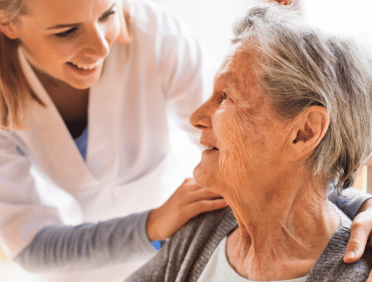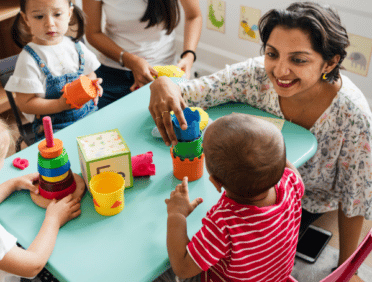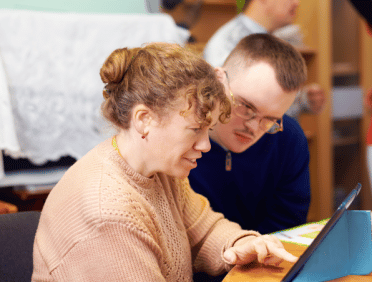Filter by
The Critical Aspects of Health and Social Care
When it comes to the provision of health and social care in the United Kingdom, safeguarding in care is an essential component. It includes a variety of protocols that are intended to safeguard the health, well-being, and human rights of individuals, making certain that they are protected from being harmed, abused, or neglected in their daily lives.
The responsibility of safeguarding in care is a shared one, and it demands a commitment to protecting the most vulnerable people of society. It is possible for care providers and professionals to guarantee that individuals receive the protection and assistance they require in order to live a life that is both secure and dignified if they adhere to the principles of safeguarding, have a grasp of the legal framework, and fulfil their tasks and obligations.
Principles of Safeguarding
Empowerment
One of the most important aspects of protection is empowerment. It entails assisting individuals in making their own decisions and supplying them with knowledge, advice, and support so that they may make their decisions in an informed manner. One of the fundamental beliefs that underpins this principle is the notion that every individual ought to be accorded dignity and respect and that their autonomy ought to be protected.
Prevention
Preventative measures are preferable to curative ones. It is the goal of safeguarding measures to prevent instances of abuse and neglect before they take place. The creation of safe surroundings, the development of awareness, and the training of staff members to detect and respond to indicators of abuse and neglect are all necessary steps in this process.
Taking preventative measures is a proactive approach that requires collaboration with several different organisations and stakeholders.
Proportionality
When safeguarding responses are proportional to the danger that is being presented, proportionality guarantees that they are appropriate. This notion acknowledges that interventions that are carried out with excessive zeal can be just as detrimental as those not carried out at all. Maintaining a healthy equilibrium between protecting an individual and honouring their rights and preferences is essential.
Protection
Protecting people means providing assistance and acting as a representative for those who are in the greatest need. Among these measures is the guarantee that they will receive the required care and support to protect them from any potential damage. It is necessary to be vigilant and to have a solid awareness of the signs and symptoms that are associated with abuse and neglect.
Partnership
Partnerships between individuals, carers, families, professionals, and agencies are essential to the execution of effective safeguarding protocols. Collaborating with one another guarantees that the varied requirements of individuals are satisfied and that answers to issues regarding the protection of individuals are well-coordinated and efficient.
Accountability
Transparency in safeguarding methods is an essential component of accountability. Every individual and every organisation has a responsibility to take responsibility for their actions and choices. Among these are the establishment of distinct roles and duties, as well as the guarantee of the existence of procedures for monitoring and evaluation.
Legal Framework
The Care Act 2014
One of the most important pieces of legislation in the United Kingdom is the Care Act of 2014, which specifies the responsibilities of local authorities and care providers with relation to the protection of vulnerable individuals. The framework for protecting adults who are in danger of abuse and neglect is established, and the establishment of Safeguarding Adults Boards is mandated as a result of this legislation.
The Children Act 1989 and 2004
These Acts constitute the legislative framework that is responsible for protecting children in the United Kingdom. Specifically, they highlight the significance of the child’s well-being and provide a description of the responsibilities that local authorities and other organisations have in order to guarantee the children’s safety and well-being.
The Safeguarding Vulnerable Groups Act 2006
Through the establishment of the Independent Safeguarding Authority (ISA) and the establishment of the framework for the vetting and barring process, this Act ensures that individuals who are not suitable to work with children and adults who are vulnerable are barred from doing so.
Roles and Responsibilities
Care Providers
The provision of care is an essential component of the safeguarding process. These persons are accountable for the establishment of secure environments, the training of personnel, and the implementation of policies and procedures that safeguard individuals from potential danger. In addition to this, they are obligated to make certain that any problems regarding safety are swiftly reported and resolved.
Local Authorities
The protection and promotion of the well-being of children and adults who are vulnerable members of society is a statutory obligation for local authorities. Inquiries and investigations into issues regarding the protection of individuals are their responsibility, and they are also responsible for coordinating responses across other organisations.
Health and Social Care Professionals
Professionals in the fields of health and social care are frequently the initial point of contact with individuals who are at risk of harm. They are required to maintain vigilance, identify evidence of abuse and neglect, and take the necessary steps to address the situation. It is also necessary to provide support to individuals and to report any concerns to the appropriate authorities.
Safeguarding Adults Boards (SABs)
Special Advisory Boards (SABs) are multi-agency groups that are responsible for monitoring safeguarding practices within local areas. The development of safeguarding policies, the conduct of safeguarding case reviews, and the promotion of best practices are all responsibilities that fall upon their shoulders.
Frequently Asked Questions (FAQs)
Safeguarding in the care setting entails preserving the health, well-being, and human rights of individuals, particularly vulnerable adults and children, in order to guarantee that they are able to live a life free from abuse, harm, and neglect.
Providing assistance to those who have been harmed involves a variety of actions that are aimed at preventing abuse. The purpose of safeguarding is to enhance the welfare of individuals by ensuring that they are safe and able to live their lives without fear.
To accomplish this, it is necessary to put in place rules and procedures, carry out risk assessments, and make certain that employees receive sufficient training to identify and address possible safeguarding concerns.
One other facet of safeguarding is the establishment of a positive care environment in which individuals are made to feel valued and respected and in which they are given the authority to voice their concerns without fear of punishment that may be taken against them.
Providing a continual loop of improvement and assurance, safeguarding also includes regular audits and feedback methods, which are both essential components.
In providing care, staff members, regulatory agencies, and local authorities are all involved in the role of safeguarding, which is a collective responsibility. When working with vulnerable individuals, it is the responsibility of everyone involved to ensure their safety. Employees of care homes, social workers, healthcare professionals, and volunteers are all included in this category.
Local Safeguarding Adults Boards and Safeguarding Children Boards are responsible for coordinating activities across a variety of agencies. With this responsibility comes the responsibility of providing strategic oversight. It is essential for every company to have designated safeguarding leads in order to ensure that issues are promptly reported and dealt with in a manner that is satisfactory.
According to the Care Act of 2014, it is the duty of local authorities to oversee safeguarding-related investigations and ensure that safeguarding protocols are effective. Furthermore, being watchful and reporting any indicators of abuse or neglect is a key role that family members and members of the community play in the process of safeguarding.
Through the utilisation of the expertise and resources of a variety of different organisations, the incorporation of multi-agency collaboration ensures the implementation of an all-encompassing strategy for the protection of individuals.
Safeguarding covers various types of abuse, including:
Physical abuse
Inappropriate use of medication or physical contact, such as hitting, slapping, or pushing. An injury such as a bruise, a fracture, or another type of bodily harm could result from this.
Emotional abuse
Verbal abuse, threats, and harassment are taking place. Among them are behaviours that are known to induce feelings of worry or psychological distress.
Sexual abuse
Sexual activity of any kind that does not involve permission. From unwanted contact to rape and sexual exploitation, this encompasses a wide range of behaviours.
Financial abuse
Theft, fraud, or coercion in financial matters are all possibilities. Unauthorised use of a person’s money or property is one illustration of this type of crime.
Institutional abuse
Within a care setting, inadequate care standards or practices are present. Included under this category are practices and routines that are either harmful or neglectful.
Neglect
Not being able to provide for fundamental requirements, such as food, hygiene, or medical care. Consequently, this may result in serious health complications or a decline in health.
Self-neglect
The act of a person disregarding their own well-being or safety. The manifestation of this could be a lack of personal hygiene, housing situations that are not sanitary, or a refusal to receive necessary care. The identification of these types of abuse is essential for the successful protection of individuals.
The community and the staff are able to maintain their awareness of the signs and symptoms of various types of abuse through the implementation of awareness campaigns and regular training sessions.
The six key principles are:
Empowerment
Offering assistance to individuals so that they can make their own decisions and give their informed consent. In order to accomplish this, it is necessary to respect their choices and encourage their autonomy.
Prevention
Preventing potential danger by taking action. Not only does this involve educating individuals and staff, but it also involves conducting risk assessments and putting preventative measures in place.
Proportionality
Responding in a manner that is appropriate to the level of risk. By doing so, interventions are guaranteed to be well-balanced and not excessively obtrusive.
Protection
Safeguarding and protecting individuals from harm. Whenever there are issues regarding the protection of individuals, this calls for a prompt and efficient response.
Partnership
Contributing to the protection of individuals by working with other organisations. Through the pooling of resources and knowledge, collaboration strengthens the efficiency of efforts to protect.
Accountability
monitoring and ensuring that safeguarding procedures are open and accountable. In order to accomplish this, thorough documentation of safeguarding actions, as well as regular reviews and audits, are required.
These guiding principles serve as a framework for the creation and implementation of safeguarding policies and procedures. They guarantee that an approach that is both comprehensive and person-centered is utilised throughout the entire process.
Carers are able to establish a secure and encouraging atmosphere that places an emphasis on the health and happiness of vulnerable individuals if they adhere to these guidelines.
Some of the signs that may be present are injuries that cannot be explained, changes in behaviour, withdrawal, dread of particular people, poor hygiene, and irregularities in financial matters.
Employees must be educated on how to identify and react appropriately to these indicators. Burns, fractures, and bruising are some examples of the physical indications that may be present. Some examples of behavioural markers are anxiety, depression, or violence that is not typical.
There are a number of indicators that can point to neglect, including starvation, dehydration, and poor living conditions. Alterations in one’s financial circumstances that occur suddenly or the disappearance of personal goods are both possible indicators of financial abuse.
Participating in regular training and awareness courses enables staff members to be more vigilant and respond effectively to any concerns regarding the protection of children and other vulnerable individuals. As a result of the fact that subtle symptoms, such as an individual being abnormally silent or reluctant to communicate, can also be markers of underlying difficulties, it is necessary for staff members to be aware of these signs as well.
The staff should thoroughly document their observations and report any concerns in accordance with the protocols that have been developed for the purpose of precautionary measures.
They should immediately communicate their concerns to their manager or the person in charge of safeguarding, document their observations, and make sure that the individual who is in danger is secure. It is of the utmost importance to adhere to the safeguarding policy of the organisation, which normally includes informing the police and the local council, if necessary.
The individual providing care should not conduct their own investigation into the situation but rather deliver a straightforward and factual assessment of their concerns. Following the priority of ensuring the individual’s immediate safety and well-being, the next step is to report the situation to the right authorities in a timely manner.
Care staff should also offer emotional support to the affected person. This includes assuring the individual that they are safe and that their concerns are being taken seriously.
Throughout the entirety of the process, it is of the utmost importance to retain confidentiality and sensitivity in order to protect the sense of dignity and privacy of the individual.
Key legislation includes:
Care Act 2014
The Care Act of 2014 establishes the framework for the protection of adults, with an emphasis on the responsibilities of local authorities and the significance of well-coordinated responses to concerns regarding protected individuals.
Children Act 1989 and 2004
Both the Children Act of 1989 and the Children Act of 2004 establish the legal framework for the protection of children and mandate the provision of services to support children who are facing difficulties.
Safeguarding Vulnerable Groups Act 2006
The Safeguarding Vulnerable Groups Act of 2006 provides the legal framework for screening people and prohibiting them from working with vulnerable groups. This ensures that those who are a potential threat are stopped from working in care settings.
Mental Capacity Act 2005
The Mental Capacity Act of 2005 protects people who are unable to make decisions for themselves and makes sure that those decisions are in their best interests. This act was enacted in order to protect these individuals.
The passage of these laws results in the establishment of a complete legal framework for safeguarding, which guarantees the protection and assistance of vulnerable individuals. In addition, the Human Rights Act of 1998 and the Equality Act of 2010 both play key roles in safeguarding by ensuring that the rights of persons are protected and that discriminatory acts are outlawed.
It is imperative that those who provide care remain knowledgeable about these regulations and incorporate their needs into their day-to-day operations.
The Care Quality Commission (CQC) is responsible for regulating and inspecting care services to ensure that they adhere to core standards of quality and safety, which include safeguarding measures.
The Care Quality Commission (CQC) is responsible for monitoring the degree to which care providers protect individuals from being harmed or abused and has the authority to take enforcement action in the event that services do not meet these criteria.
Evaluations of the safeguarding practices that are now in place are commonly included in the inspection reports that are produced by the CQC. This is done in order to guarantee transparency and accountability. In addition to this, they offer guidance and help to those who provide care in order to improve the safety precautions that organisations already have in place.
Setting clear standards and encouraging best practices within the care sector are two of the ways in which the Care Quality Commission (CQC) supports a culture of continuous improvement. According to the Care Quality Commission (CQC), providers are obligated to report serious safeguarding occurrences to the CQC.
The CQC then evaluates how well these incidents are managed and what measures are taken to prevent other incidents from occurring.
On a regular basis, often once a year, as well as whenever there are modifications in legislation or best practices, training on safeguarding should be carried out. Staff members are kept up to date with the most recent safeguarding policies, procedures, and regulatory requirements through the implementation of ongoing training.
Staff members are better able to successfully respond to concerns regarding safeguarding when they have strengthened their knowledge and awareness through the use of refresher training. As part of the onboarding process, it is essential that newly hired staff receive extensive training on how to protect themselves and others.
When it comes to safeguarding, staff members who work with specific groups, such as persons with dementia or learning impairments, may benefit from obtaining specialised training in order to meet the specific challenges that they experience. This training can help them manage the specific concerns that they confront.
The incorporation of real-life situations and case studies into training programmes should be for the purpose of strengthening both the grasp of safeguarding ideas and their implementation in day-to-day practice.
A safeguarding policy is a document that details the procedures and regulations that are in place to protect vulnerable individuals from becoming victims of abuse or neglect.
Included in it should be:
Reporting mechanisms
Provide information on how and where to report concerns, including contact information for those in charge of safeguarding and external authorities.
Roles and responsibilities
A distinct demarcation of who is responsible for what, including the particular responsibilities of safeguarding staff members and leaders, is essential.
Prevention strategies
A number of preventative measures, including but not limited to the training of staff members, the conduct of background checks, and the establishment of a positive care environment.
Intervention guidelines
Detailed reporting processes and quick actions to protect the individual are included in the steps to take in the event that abuse is suspected.
Training requirements
Education that is ongoing for staff members to ensure that they are always up to date on the latest safeguarding practices and regulatory obligations.
Documentation procedures
The correct documentation of incidents and the actions taken, with the goal of ensuring a transparent and precise account of concerns regarding safety,. The implementation of a well-developed safeguarding policy guarantees a methodical approach to the protection of individuals in care settings.
Reviewing and updating it on a regular basis is necessary in order to take into account any changes in legislation or best practices. The policy must be freely accessible to all of the staff members and communicated in a clear manner in order to guarantee comprehension and compliance.
It ought to include information on how to provide assistance to victims of abuse and how to promote their rehabilitation and overall well-being.
Monitoring and revising their safeguarding rules on a regular basis, providing ongoing training for their employees, doing comprehensive background checks, and ensuring that their reporting and documentation systems are crystal clear.
Conducting regular audits and inspections is essential in order to identify and address any potential loopholes in the safeguarding procedures that may exist. There are additional ways to increase compliance, like participating in training sessions that involve several agencies and getting active with local safeguarding boards.
When it comes to keeping a secure and compliant care environment, it is essential to make certain that staff members comprehend and adhere to the safeguarding standards of the organisation. A culture of openness and transparency should also be fostered in residential care facilities, prompting both staff and residents to voice their concerns without fear of being punished for doing so.
It is possible to gain useful insights into the effectiveness of safeguarding measures and areas for improvement by making use of input from residents, families, and other stakeholders from the outside.
Legal action, a loss of reputation, financial penalties, and even the termination of the care service are all potential consequences. Furthermore, it has the potential to result in the abuse or damage of people who are vulnerable.
There is the potential for individuals who are culpable for carelessness to face criminal prosecution, and regulatory agencies such as the CQC have the ability to impose punishments. It is the most serious issue that the influence will have on the health and safety of individuals who are receiving care, which highlights the significance of implementing stringent safeguarding measures.
There is also the possibility that failing to safeguard can result in a loss of trust from the community, which can have a negative impact on the ability of the care provider to attract and keep clients and personnel. In addition, organisations could incur financial losses as a result of the charges associated with legal proceedings and compensation claims.
It is possible for victims and their families to suffer a significant and long-lasting emotional and psychological toll, which highlights the moral and ethical responsibility to prioritise the protection of those who are vulnerable.
Access to medical care, counselling, advocacy services, and legal assistance are all included in the support that someone receives. Local authorities and organizations, such as Action on Elder Abuse, also offer resources and assistance.
It is of the utmost importance to provide both immediate and long-term care for victims in order to promote their recovery and help them regain a sense of safety and well-being. Those who offer care should have procedures in place so that they can connect victims with the services they require, as well as ensure that they continue to receive protection and assistance on an ongoing basis.
It is essential to establish a supportive environment in which victims are able to feel heard and validated. Additionally, the significance of peer support groups and community services cannot be overstated in relation to the rehabilitation process.
The capacity to make well-informed decisions regarding their care and the path to recovery is afforded to victims when they are provided with assurances regarding their rights and the different help options that are available to them.
Through the use of electronic health records, monitoring systems, training modules, and reporting tools, technology can be of assistance in ensuring that safeguarding practices are carried out in a timely and correct manner.
Instances may be tracked, patterns can be identified, and information can be disseminated among specialists in an appropriate manner with the assistance of digital tools. Platforms for online training offer staff members a flexible and all-encompassing education in the area of safeguarding.
Abuse can also be prevented with the help of monitoring systems like CCTV, which can also provide evidence for investigations. Innovative technologies such as artificial intelligence and machine learning have the ability to forecast and recognise future threats to safety, which enables proactive measures to be taken.
Concerns can be submitted in real time through the utilisation of mobile applications and digital platforms, which guarantees that prompt responses are carried out whenever they are received. People who may be in danger can receive remote support and counselling through telehealth programmes, which have the capability to provide these services.
A multi-agency approach guarantees complete support and protection by leveraging the skills and resources of a variety of organisations, such as those dealing with health, social services, law enforcement, and community groups.
When multiple agencies work together, they are better able to manage complicated safeguarding issues, which helps to ensure that all parts of an individual’s requirements are carefully considered. Attending meetings with many agencies and participating in collaborative training sessions helps to improve communication and coordination, which ultimately results in more strong safeguarding practices.
The use of this approach not only makes it possible to avoid the repetition of efforts, but it also ensures that resources are employed in an efficient manner. By working together, organisations are able to develop a shared understanding of the factors that provide risks and those that provide protection, which eventually leads to the development of interventions and support programmes that are more efficient.
When it comes to the objective of refining practices within the sector, multi-agency evaluations of safeguarding cases can also provide valuable insights and lessons.
Family members and communities have an essential role in identifying and reporting symptoms of abuse, providing assistance to those who are vulnerable, and working together with care professionals to protect the safety of those individuals.
Engaging with families and communities helps to develop a network of support around the individual, which increases the likelihood that abuse will be recognised and addressed in a timely manner. It is important for those who provide care to foster open communication and involve families in the process of planning and making decisions regarding care arrangements.
Community awareness programmes have the potential to educate the general population about the warning signs of abuse and the significance of protecting these individuals. Providing families and communities with the knowledge and tools necessary to empower them helps them act as advocates and guardians for those who are vulnerable.
Support groups and community organisations can also be of great benefit to families who are caring for vulnerable members of their family by providing them with respite and essential assistance.
This can be accomplished by establishing a setting that is secure and encouraging, providing regular opportunities for feedback, delivering unambiguous information regarding their rights, and making sure that reporting procedures are easily accessible.
It is important to listen to the concerns of individuals, respect their autonomy, and take their reports seriously in order to empower them. Individuals may also feel more confident in their ability to speak out about abuse if advocacy services are provided to them.
Actively promoting a culture of openness and transparency in which people feel appreciated and respected is something that care providers should do. The need for training professionals to respond to allegations of abuse in a compassionate and efficient manner cannot be overstated.
Individuals who are receiving care can feel more empowered to speak up when they are provided with instructions on how to recognise abuse and understand their rights under the law.
When it comes to successful safeguarding, it is of the utmost importance to ensure that the procedures for reporting are user-friendly and accessible. This includes making sure that the procedures are accessible to those who have disabilities or language challenges.
SARs are carried out with the purpose of gaining knowledge from situations in which an adult who is at risk has been subjected to abuse or neglect. Their objective is to enhance existing safeguarding methods and forestall the occurrence of similar catastrophes.
When there is a perception that agencies could have worked more successfully to protect an individual, search and rescue operations (SARs) are more likely to be undertaken. As part of the evaluations, a comprehensive examination of the circumstances, the identification of lessons learned, and the formulation of recommendations for future practice are all included.
When it comes to building a culture of continuous improvement in safeguarding, SARs are an essential instrument. They offer the chance to investigate and contemplate the actions taken by authorities, as well as to uncover systemic issues that may have played a role in the abuse or neglect that occurred.
Over the course of the care industry, the findings from SARs ought to be widely shared in order to facilitate the establishment of policies and the improvement of practices. In addition to providing useful insights, engaging with families and individuals who are involved in search and rescue operations may ensure that their points of view are taken into consideration when developing future protection measures.
Through the implementation of the principles outlined in the Mental Capacity Act, the guarantee that individuals are involved in the decision-making process about their care, and the utilisation of the least restrictive interventions that are required to safeguard them,.
Recognising the individual’s freedom to make decisions regarding their own life, especially if those decisions include a certain degree of risk, is an essential component of respecting autonomy. It is the responsibility of those who provide care to assist individuals in making well-informed decisions by providing them with direction and knowledge while also respecting their requests and preferences.
This includes completing comprehensive capacity evaluations to identify the individual’s ability to make particular decisions and involving them in the decision-making process to the greatest extent possible. Care plans ought to be person-centred, meaning that they should reflect the values, preferences, and objectives of the individual.
If care providers foster a culture that values respect and dignity, they can protect people’s rights while also ensuring their safety and well-being.
Reviewing and updating care plans on a regular basis helps to ensure that they continue to be applicable and responsive to the requirements and circumstances of the individual.
The oversight of safeguarding practices, the provision of training and assistance to staff, the management of safeguarding concerns, and the coordination of communication with other agencies are all things that fall under their purview.
Safeguarding leaders are accountable for ensuring that rules are followed and that problems are resolved in a timely and appropriate manner. This responsibility requires them to ensure that issues are addressed. One of the most important responsibilities that they carry out is to ensure that they have a current awareness of the laws and procedures that are in place to protect the environment.
This helps to ensure that the care setting continues to be compliant and effective in protecting vulnerable individuals. Those in charge of safeguarding should be friendly and easily accessible to both workers and individuals receiving care in order to cultivate an atmosphere in which protection assumes a high priority.
As part of their efforts to provide a response that is both thorough and effective, they usually take part in the process of conducting investigations into concerns concerning the protection of individuals, working in conjunction with local authorities and other agencies.
Reviewing and auditing safeguarding practices on a regular basis within the care setting helps identify areas that could be improved and ensures that safeguarding measures are continuously improved.
When it comes to developing a culture of learning and ensuring that the well-being of staff members is taken into account, safeguarding leads play a significant role in debriefing and offering support to staff members who were involved in incidents regarding safeguarding. Their role also includes ensuring that the well-being of staff members is taken into consideration.















